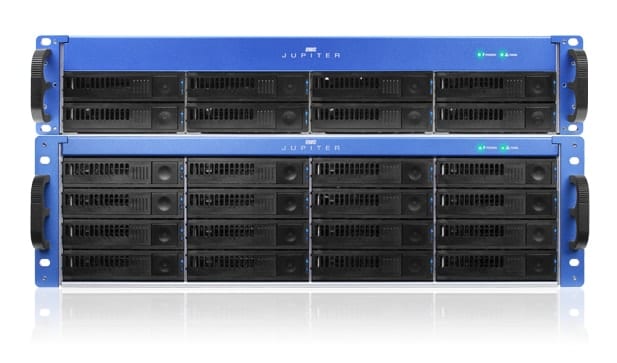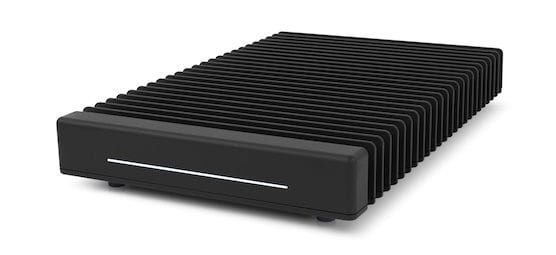The digital landscape is an ever-changing one, especially when it comes to storage. With 4K, 5K, and 8K workflows becoming the new standard, data requirements are exponentially growing almost on a weekly basis. Many customers know about how OWC’s flagship products including our docks, ThunderBay 4, ThunderBlade, Helios enclosures, and even our Mac upgrades can fit into these workflows. But we wanted to take some time to shed some light on our Enterprise RAID systems, Jupiter – what it does, and who it can benefit.

Firstly, let’s explain some key vernacular so we can start this from a defined perspective.
RAID: Data storage technology that combines multiple physical disks, or flash storage into one or more logical units for purposes of data redundancy, or performance gain. (Read more about the different RAID configurations here. OWC also offers a powerful software RAID solution SoftRAID.)
Filesystem: Layer of software that controls how data is stored and retrieved. (HFS, NTFS, APFS, ZFS, etc.)
NAS: Networked Attached Storage, a file level device that serves data to other devices on a network via various network protocols. (An example would be OWC Jupiter Callisto systems.)
SAN: Storage Area Network, provides block-level access to servers, or other attached devices, where direct access is necessary. Logically presents itself as being directly attached but is not. (OWC Jupiter Kore is an example.)
 DAS: Direct attached Storage, is a form of digital storage directly attached to a computer or server as opposed to over a network. (OWC’s offerings include ThunderBay, ThunderBlade, Mercury line, Envoy line, among others.)
DAS: Direct attached Storage, is a form of digital storage directly attached to a computer or server as opposed to over a network. (OWC’s offerings include ThunderBay, ThunderBlade, Mercury line, Envoy line, among others.)
ZFS: Zettabyte File System, is the only 128-bit filesystem. It is highly scalable, protects against data corruption, has efficient data compression, has continuous integrity checking, and leverages memory for sustained performance. It is used in our Jupiter Callisto NAS systems.
The Jupiter line
The OWC Jupiter line, in a nutshell, is defined as RAID-based storage devices, designed for production and mission-critical environments where data integrity and availability are the highest priority.
Jupiter Callisto: Rack form factor, 8 and 16 bay ZFS based NAS, SAN device. It leverages self-healing algorithms, error correcting, and Flash memory cache to offer a very high speed, low-cost turnkey RAID system. It offers the same features, quality, and longevity that is expected at the Enterprise level, without the extreme cost of deployment usually associated with it.
Jupiter Kore: A rack form factor, 8 bay and 16 bay JBOD, and expansion system. This device is added to our Jupiter Callisto to expand the storage capacity and parity. It is technically a DAS (Direct Attached Storage) device. Meaning that without an overarching system it cannot serve data, it can also be used by a standard Mac, or PC with the use of a SAS card. The main Callisto System can be expanded into the Petabytes with multiple Kore Systems.
Some simplified workflow examples include…
![]() Typical file server: This would allow many users, to connect over a network and allow for secure data retrieval and archive functions. It would allow users to have backups, view and manage media, and documents as well as seamless collaboration on shared projects. The system could even have a bespoke backup Jupiter Callisto that would serve as a failsafe should something go wrong with the primary system and would prevent downtime.
Typical file server: This would allow many users, to connect over a network and allow for secure data retrieval and archive functions. It would allow users to have backups, view and manage media, and documents as well as seamless collaboration on shared projects. The system could even have a bespoke backup Jupiter Callisto that would serve as a failsafe should something go wrong with the primary system and would prevent downtime.
Collaborative post-production: This is very popular with customers that require high-speed data transfers, data integrity, high capacities, and the ability to collaborate while editing large format media, HDR, RAW etc. Most users will install 10Gb networking equipment from the user all the way up to host (Callisto.) This allows for up to 10Gb transfer speeds per user. Time savings alone pay for the increase in cost associated with high-speed networking equipment. Data is safeguarded in a central repository with multiple parity options, and seamless expansion options.
Large-scale archive: Callisto using ZFS (Zettabyte Filesystem) is the best way to keep data secure. Not only with simple data parity, but the fact that it repairs data over time, and stops data rot (when data becomes corrupted over time). This means that Callisto can be used as a long-term archive second only to something like LTO for long-term viability. Usually, these systems are configured with larger parity schemes such as RAIDZ-3 (triple disk parity,) and in some cases replicate to an offsite backup.
Our Jupiter Engineers deal with data for a living. We know what it takes to get the best most efficient workflow designed for you, what might work for one customer might not work for another. That is why we take the time to design an end-to-end data solution for our customers. We go the extra mile to assess needs, growth strategies, performance requirements, and we offer inclusive insight based on years of data and real-world expertise. OWC is and continues to be the premier one stop shop for all your data flow needs.
• Luke J.H. Engstrom is the Jupiter Product Engineer at OWC. He can be reached at lengstrom@owcdigital.com






